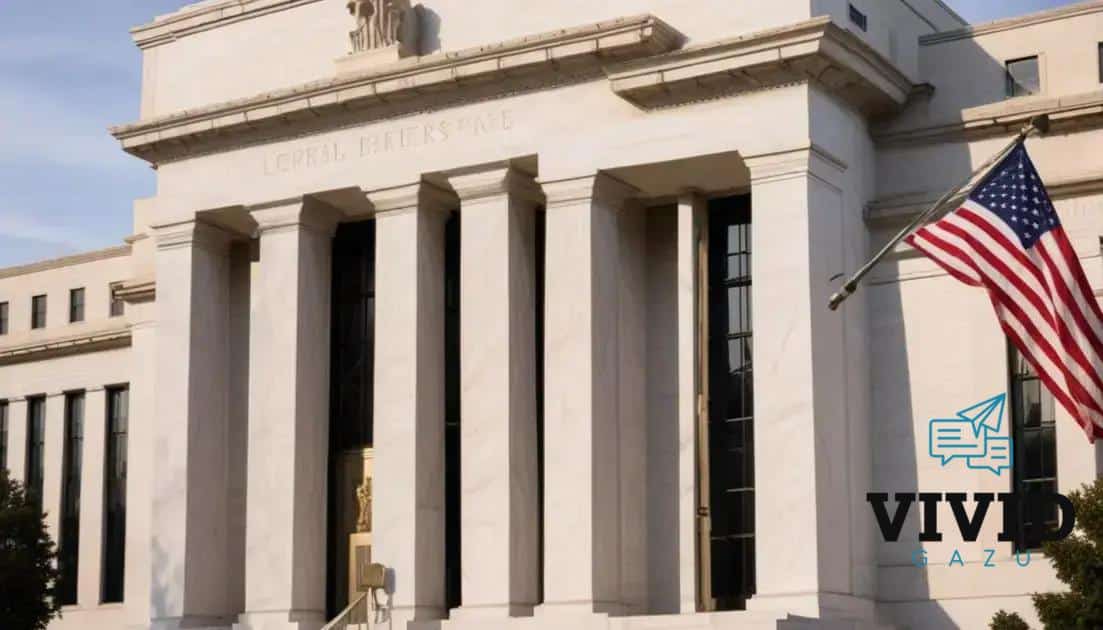Federal Reserve’s potential interest rate adjustments explained

The Federal Reserve’s potential interest rate adjustments directly influence borrowing costs, savings rates, and overall economic conditions, making it crucial for individuals to stay informed for better financial decision-making.
Federal Reserve’s potential interest rate adjustments are a hot topic that can sway markets and influence your wallet. Ever wondered how these changes affect your loans, savings, or investments? Let’s dive in.
Understanding the Federal Reserve’s role
Understanding the Federal Reserve’s role is essential for grasping how the economy functions. As the central bank of the United States, it influences monetary policy and regulates financial institutions, ensuring stability within the financial system.
The Functions of the Federal Reserve
The Federal Reserve operates through three main functions: supervising banks, conducting monetary policy, and maintaining financial stability.
- Supervision: The Fed oversees and regulates banks to ensure they operate safely and soundly.
- Monetary Policy: It adjusts the money supply and interest rates to promote maximum employment and stable prices.
- Financial Stability: The Fed monitors and addresses systemic risks to prevent financial crises.
The decision-making process involves the Federal Open Market Committee (FOMC), which meets regularly to review economic conditions and set appropriate policy directions. The Federal Reserve uses tools like open market operations, the discount rate, and reserve requirements to manage liquidity and control inflation.
Impact on the Economy
The actions of the Federal Reserve have far-reaching effects on various sectors of the economy. For instance, changes in interest rates can affect borrowing costs for consumers and businesses.
When the Fed lowers rates, borrowing becomes cheaper, stimulating spending and investment. Conversely, increasing rates can help cool down an overheating economy by making loans more expensive. This balancing act is crucial as it helps to foster sustainable growth.
As the Federal Reserve navigates complex economic challenges, it balances the needs of different economic sectors while trying to achieve long-term goals.
Recent interest rate trends

Recent interest rate trends provide insight into the direction of the economy and how monetary policy is evolving. Keeping track of these trends is vital for understanding market conditions and making informed financial decisions.
Current Trends in Interest Rates
In the past year, interest rates have been on the rise as the Federal Reserve responds to inflationary pressures. This upward movement aims to curb inflation and stabilize the economy.
- Gradual Increases: The Federal Reserve has implemented a series of gradual rate hikes.
- Impact on Borrowing: Higher rates are increasing borrowing costs for consumers and businesses.
- Market Reactions: As rates rise, equity markets may experience volatility.
These trends affect everything from mortgage rates to credit cards. As businesses adjust their strategies to manage costs, consumers may also need to rethink their financial plans.
Historical Context
Comparing current trends to historical data shows how changes in policy shape the economic landscape. Over the past decade, interest rates hovered at historic lows, primarily to stimulate economic growth post-recession.
Conversely, the recent hike is a significant shift, reflecting the Fed’s commitment to tightening monetary policy. This shift raises questions about the long-term impacts on spending and growth.
Understanding recent interest rate trends helps individuals and businesses navigate future economic scenarios better. As the landscape evolves, staying informed can lead to better financial decisions.
Factors influencing rate adjustments
Factors influencing rate adjustments play a crucial role in the decisions made by the Federal Reserve. Understanding these factors helps clarify why interest rates fluctuate over time.
Economic Indicators
Several key economic indicators influence rate adjustments. These include inflation, unemployment rates, and GDP growth. As inflation rises, the Federal Reserve may increase rates to keep prices in check.
- Inflation: Higher inflation often leads to higher interest rates to prevent the economy from overheating.
- Unemployment: Low unemployment may prompt the Fed to raise rates as a measure to control wage growth.
- GDP Growth: Strong GDP growth can signal a healthy economy, prompting rate increases to manage inflation.
These indicators provide a snapshot of overall economic health, guiding the Fed’s monetary policy decisions.
External Factors
Global events also play a critical role in shaping rate adjustments. Factors such as geopolitical tensions, trade disputes, and foreign economic performance can influence the Fed’s actions.
For example, if a major trading partner faces economic turmoil, the Fed may hold off on rate increases to support domestic growth. Moreover, changes in foreign interest rates can lead to shifts in investment flows, affecting the U.S. economy.
Understanding the factors influencing rate adjustments allows consumers and businesses to better navigate potential financial changes. By staying informed, individuals can make more strategic decisions regarding loans, investments, and savings.
Potential impacts on the economy

Understanding the potential impacts on the economy is crucial as interest rates adjust. These changes can influence consumer behavior, business investments, and even overall economic growth.
Effects on Consumer Spending
When interest rates rise, borrowing becomes more expensive. This can lead to a decrease in consumer spending as people may delay purchases of items such as homes and cars. Higher loan costs mean that families must budget more carefully.
- Mortgage Rates: Increased rates can lead to higher monthly payments for new home buyers.
- Credit Cards: Consumers may face increased interest on credit card balances, discouraging excessive spending.
- Auto Loans: Higher rates can impact car buyers, making financing less attractive.
As spending slows, this can lead to decreased demand for goods and services, which may hinder economic growth.
Influence on Business Investments
Businesses also react to changes in interest rates. When rates rise, many companies think twice before investing in expansion or new projects. High borrowing costs can strain their budgets.
This hesitance can result in reduced hiring rates and slower wage growth. Additionally, businesses might tighten their overall spending, impacting their growth plans.
In contrast, when interest rates are low, companies may feel more confident borrowing money for investments. This can stimulate economic growth and job creation.
Understanding the potential impacts on the economy of interest rate adjustments helps individuals and businesses prepare for changes. These insights can guide financial decisions, whether regarding loans, savings, or investment strategies.
What it means for your finances
Understanding what it means for your finances in the context of interest rate changes is essential for making informed personal financial decisions. These changes can significantly impact everything from loans to savings rates.
Loans and Borrowing Costs
When interest rates rise, borrowing costs usually increase. This means that loans for homes, cars, or personal finance become more expensive. As a result, individuals may choose to delay making big purchases or consider more affordable options.
- Mortgage Rates: Higher rates can lead to increased monthly payments for home buyers.
- Auto Loans: Loans for cars will also come with higher costs, affecting what buyers can afford.
- Student Loans: For those with variable-rate loans, payments could increase, straining budgets.
Planning for these costs is crucial as they affect monthly budgets and overall financial health.
Savings and Investment Returns
On the flip side, rising interest rates can positively influence savings accounts and fixed-income investments. Higher rates usually lead to better returns, encouraging saving. This can benefit individuals as they earn more on their deposits.
Investors may also seek opportunities in bonds and other fixed-income securities, which can see increased yields. Properly reallocating investments during these rate changes increases potential financial benefits.
Staying informed about what interest rate changes mean for your finances helps you adjust your financial strategies proactively. It’s vital to evaluate your financial situation regularly, aligning spending and saving habits with current economic conditions.
FAQ – Frequently Asked Questions about Federal Reserve Interest Rate Adjustments
How do interest rate adjustments affect loan costs?
When interest rates rise, borrowing becomes more expensive. This often leads to higher monthly payments on loans such as mortgages and auto loans.
What impact do rising rates have on savings accounts?
As interest rates increase, savings accounts typically offer better returns, encouraging people to save more.
Why should I monitor interest rate trends?
Monitoring interest rate trends helps you make informed decisions about loans, investments, and savings, ensuring better financial management.
How can interest rate changes impact my budgeting?
Changes in interest rates can affect your monthly expenses, including loan repayments and savings interest, so adjusting your budget accordingly is crucial.





